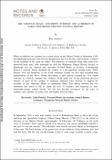Files in this item
The ‘Stronsay Beast’ : testimony, evidence and authority in early nineteenth-century natural history
Item metadata
| dc.contributor.author | Jenkins, Bill | |
| dc.date.accessioned | 2022-03-25T11:30:11Z | |
| dc.date.available | 2022-03-25T11:30:11Z | |
| dc.date.issued | 2023-08-02 | |
| dc.identifier | 277679978 | |
| dc.identifier | c92461e8-a012-475d-8f67-ab68d3eea813 | |
| dc.identifier | 85124674083 | |
| dc.identifier | 000746803500001 | |
| dc.identifier.citation | Jenkins , B 2023 , ' The ‘Stronsay Beast’ : testimony, evidence and authority in early nineteenth-century natural history ' , Notes and Records: the Royal Society Journal of the History of Science , vol. 77 , no. 3 , pp. 471-494 . https://doi.org/10.1098/rsnr.2021.0050 | en |
| dc.identifier.issn | 0035-9149 | |
| dc.identifier.other | RIS: urn:70B023974F19FD543B7BDB4825702366 | |
| dc.identifier.other | ORCID: /0000-0002-0625-2685/work/107718336 | |
| dc.identifier.uri | https://hdl.handle.net/10023/25106 | |
| dc.description.abstract | When an unknown sea creature was washed ashore on the Orkney Islands in September 1808, the Edinburgh anatomist John Barclay declared that this was the first solid scientific evidence for the existence of the ‘great sea snake’. The testimony of witnesses along with some of its preserved body parts were examined by both the Wernerian Natural History Society in Edinburgh and the surgeon and anatomist Everard Home in London. Contradicting Barclay's opinion, Home identified the creature as a decomposing basking shark. While Barclay took the testimony of the local witnesses largely on trust and accepted their interpretation of the Beast, Home discounted it and instead asserted his own expert authority to correctly interpret the evidence. Both made use of the preserved physical remains of parts of the creature in strikingly different ways: Barclay to support the accounts of the witnesses, Home to undermine them. The debate between the two anatomists has much to tell us about the uses of evidence and testimony in early nineteenth-century natural history, but also has broader resonances for the roles of evidence and authority in science that still remain relevant today. | |
| dc.format.extent | 24 | |
| dc.format.extent | 1237015 | |
| dc.language.iso | eng | |
| dc.relation.ispartof | Notes and Records: the Royal Society Journal of the History of Science | en |
| dc.subject | John Barclay | en |
| dc.subject | Everard Home | en |
| dc.subject | Sea serpent | en |
| dc.subject | Natural history | en |
| dc.subject | Testimony | en |
| dc.subject | Wernerian Natural History Society | en |
| dc.subject | C Auxiliary Sciences of History | en |
| dc.subject | QH Natural history | en |
| dc.subject | T-DAS | en |
| dc.subject | AC | en |
| dc.subject | DOAE | en |
| dc.subject | MCC | en |
| dc.subject.lcc | C | en |
| dc.subject.lcc | QH | en |
| dc.title | The ‘Stronsay Beast’ : testimony, evidence and authority in early nineteenth-century natural history | en |
| dc.type | Journal article | en |
| dc.contributor.institution | University of St Andrews. School of History | en |
| dc.identifier.doi | https://doi.org/10.1098/rsnr.2021.0050 | |
| dc.description.status | Peer reviewed | en |
This item appears in the following Collection(s)
Items in the St Andrews Research Repository are protected by copyright, with all rights reserved, unless otherwise indicated.

